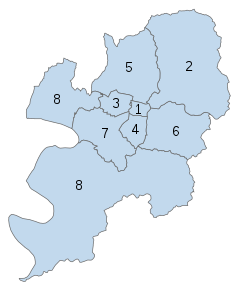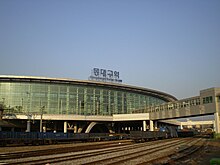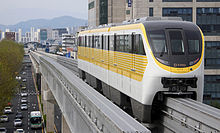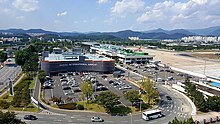Daegu
Coordinates: 35 ° 52 ' N , 128 ° 35' E
| Big city of Daegu | |
|---|---|
| Hangul : | 대구 광역시 |
| Hanja : | 大邱 廣域 市 |
| Revised Romanization : | Daegu Gwangyeoksi |
| McCune-Reischauer : | Taegu Kwangyŏksi |
| Basic data | |
| Surface: | 885.62 km² |
| Residents: | 2,491,545 (as of April 30, 2015) |
| Population density : | 2,813 inhabitants per km² |
| Structure : | 7 districts ( Gu ) and one district ( Gun ) |
| Postal code : | 41000 (Deokgok-Dong) - 43022 (Guji-myeon) |
| Administrative headquarters : | Daegu |
Daegu ( Korean : 대구, [ Tɛɡu ]), formerly Taegu and officially known as Daegu Metropolitan City , is a city in Gyeongsangbuk-do Province in South Korea . Daegu is located around 240 kilometers from Seoul in the south-east of the country and, with over 2.5 million inhabitants, is the fourth largest city in South Korea after Seoul, Incheon and Busan . Politically, it forms an independent unit. The area of the city is 885.62 km² today, the altitude extends from 50 meters near the river to 600 meters on the mountain ranges. The city is located on the Nakdong River , the longest river in South Korea. Daegu is a national electrical and textile industry center in South Korea. Numerous well-known Korean companies such as the Samsung Group, TaeguTec and Kolon Industries were founded in Daegu. Due to the subtropical climate, the region around Daegu is also one of the most important fruit-growing areas in the country.
history
Only a few archaeological finds document the 2,500-year history. The name Daegu ("big hill") goes back to the year 757 AD and is probably due to a Bronze Age clay fortress.
Daegu has long been the administrative, cultural and economic center of the Southeast of Korea. Between 1392 and 1910 , during the Joseon Dynasty and Greater Korea , Daegu was the capital of Gyeongsang Province , which was split into several parts in 1896. During this period, major national markets emerged in Daegu, particularly the Yangnyeongsi Herbal Medicine Market and the Seomun Market, the third largest market during the Joseon era.
In 1905 the old fortress wall was destroyed. Korea was part of the Japanese Empire between 1910 and 1945 . Since Japanese was the national language at that time, the city name 大邱 Japanese Taikyū was read.
After the Korean War , the city grew explosively; meanwhile the population has increased more than tenfold.
On February 28, 1960, the authorities devoted to the Rhee Syng-man regime forbade the city's high school students from participating in an opposition election rally. This led to great unrest and violent attempts at repression, which in turn triggered violent protests in other cities and went down in the history books as the "Daegu Democracy Movement". Rhee Syng-man finally had to be flown to Hawaii with the help of the CIA.
On May 14, 1981, there was a serious railway accident near Daegu : At a level crossing , an express train from Pusan to Seoul hit a motorcycle, braked it and stopped. A following local train drove up, either because there was a signal interference or because the engine driver of the second train ignored a signal that required a "stop". 54 people died.
In 2002 Daegu hosted four World Cup matches , including the third place match between South Korea and Turkey.
On February 18, 2003, an apparently mentally confused assassin caused a subway disaster through arson in the city center, with well over 100 fatalities.
In 2011, Daegu hosted the 13th World Athletics Championships .
From mid-February 2020, the city also came into the international spotlight after an infection cluster from the COVID-19 pandemic was discovered in South Korea .
Current situation
Due to its inland location (hottest city in summer, coldest city in winter), Daegu is ideal for apple cultivation, which an American missionary introduced around 1880.
Today the city is a leader in the country's textile industry and is also considered a fashion hub. The range of goods is plentiful. The city has 21% of all textile manufacturers and 61% of all fabric producers in the country. There is also significant metal processing and mechanical engineering. For centuries the city has also been the center of the medicinal herb trade.
The tallest structure in the city is the 202 meter high TV tower 83 Tower . Two rivers flow through the city. In the north of the city, the Geumhogang ( Gang = 'river') flows from east to west , while the Sincheon ( Cheon = 'brook', 'small river') flows through the city center . Both rivers are accompanied by elongated parks and promenades, which fulfill a high level of recreational function within the city.
About 60 km west of the city is the Haein Buddhist Temple ( Haeinsa ) , built in 802 . As the most comprehensive collection of Buddhist texts in Asia, it guards the more than 80,000 wooden printing plates of the Tripitaka Koreana .
The Talsong Fortress Daegu is a national tourist attraction. This former fortress has protected the city from wild animals, vagabonds and violent attacks for centuries.
Daegu's drug market, known as Yangnyeongsi ( 藥 令 Arzneimittel), has a history of 350 years and is the oldest such market in Korea. It was relocated to its present location after the country was annexed by Japan in the early 20th century and still plays an important role in providing Korea with traditional medicine.
Daegu has five universities. The most important is the Kyongpook National University , founded in 1946 , which is centrally located on a spacious campus. The former Confucian School of Daegu Hyanggyo , founded in 1398, moved to its current location in 1973 and is now a school for classical Chinese and Korean etiquette.
City structure

|
|||||||||
| No. | district | Hangul | Hanja | Residents | Area (km²) | ||||
|---|---|---|---|---|---|---|---|---|---|
| 1 | Jung-gu ("Central District") | 중구 | 中 區 | 80.225 | 7.06 | ||||
| 2 | Dong-gu ("Eastern District") | 동구 | 東區 | 353.178 | 182.16 | ||||
| 3 | Seo-gu ("western district") | 서구 | 西區 | 186,796 | 17.33 | ||||
| 4th | Nam-gu ("southern district") | 남구 | 南 區 | 151.821 | 17.43 | ||||
| 5 | Buk-gu ("northern district") | 북구 | 北區 | 444,616 | 94.07 | ||||
| 6th | Suseong-gu | 수성구 | 壽 城區 | 434,399 | 76.46 | ||||
| 7th | Dalseo-gu | 달서구 | 達西 區 | 582,422 | 62.34 | ||||
| 8th | Dalseong gun | 달성군 | 達 城 郡 | 256.345 | 426.68 | ||||
| Daegu as a whole | 대구 광역시 | 大邱 廣域 市 | 2,489,802 | 883.54 | |||||
| Source: 2019 시정 현황 (report of the municipal administration) | |||||||||
economy
measure up
Daegu is a regular venue for national and international trade fairs such as the Daegu International Future Auto Expo and the Green Energy Expo.
Fashion industry
Daegu is a center of the Korean fashion industry and therefore advertises with the slogan 'Daegu: Fashion City'. The city hosts several fashion exhibitions such as the Daegu Fashion Fair. In the Bongmu-dong district in the north-east of the city, Esiapolis is a new textile industry district.
traffic
Rail transport
Daegu is the center of Korean domestic traffic. The main train line, the Gyeongbu Line, runs through the city. The city's largest train station, Dongdaegu Station, has the second highest passenger volume in South Korea after Seoul Station. The station was reopened in 2004 after extensive renovations and now serves as a station for KTX , Saemaeul and Mugunghwa trains. All types of train except the KTX also stop at Daegu Station near the city center. Daegu Station has the 10th highest number of passengers in South Korea.
metro
The Daegus metro network consists of three lines. A fourth line is being planned and will connect the other three lines as a ring line.
Street
There are two types of buses in Daegu: the regular city buses and express buses, which are faster, more expensive and have fewer stops.
air
Daegu has one international airport, Daegu International Airport in the northeast of Daegu. International destinations include Japan , China , several countries in Southeast Asia , and Vladivostok in Russia .
Town twinning
-
 Atlanta , United States , since 1981
Atlanta , United States , since 1981 -
 Almaty , Kazakhstan , since 1990
Almaty , Kazakhstan , since 1990 -
 Qingdao , PR China , since 1993
Qingdao , PR China , since 1993 -
 Minas Gerais , Brazil , since 1994
Minas Gerais , Brazil , since 1994 -
 Hiroshima , Japan , since 1997
Hiroshima , Japan , since 1997 -
 Saint Petersburg , Russia , since 1997
Saint Petersburg , Russia , since 1997 -
 Milan , Italy , since 1998
Milan , Italy , since 1998 -
 Plovdiv , Bulgaria , since 2002
Plovdiv , Bulgaria , since 2002
Personalities
Web links
- Official website (English; Korean, Chinese, Japanese selectable)
Individual evidence
- ↑ Ministry of Administration and Interior (MOGAHA, 행정 자치부): Census 2015 ( Memento of the original from March 3, 2011 in the Internet Archive ) Info: The archive link was inserted automatically and has not yet been checked. Please check the original and archive link according to the instructions and then remove this notice.
- ^ Nelles Guide Korea
- ^ Peter WB Semmens: Catastrophes on rails. A worldwide documentation. Transpress, Stuttgart 1996, ISBN 3-344-71030-3 , p. 188.
- ↑ 2019 시정 현황. (pdf) Retrieved February 22, 2020 (Korean).
- ↑ The Chosun Ilbo (2009-11-25)
- ↑ a b ko: 2008 년 철도 통계 연보 . Korea Railroad. 2010.
- ↑ Daegu Bus Information_Fare Guide .










